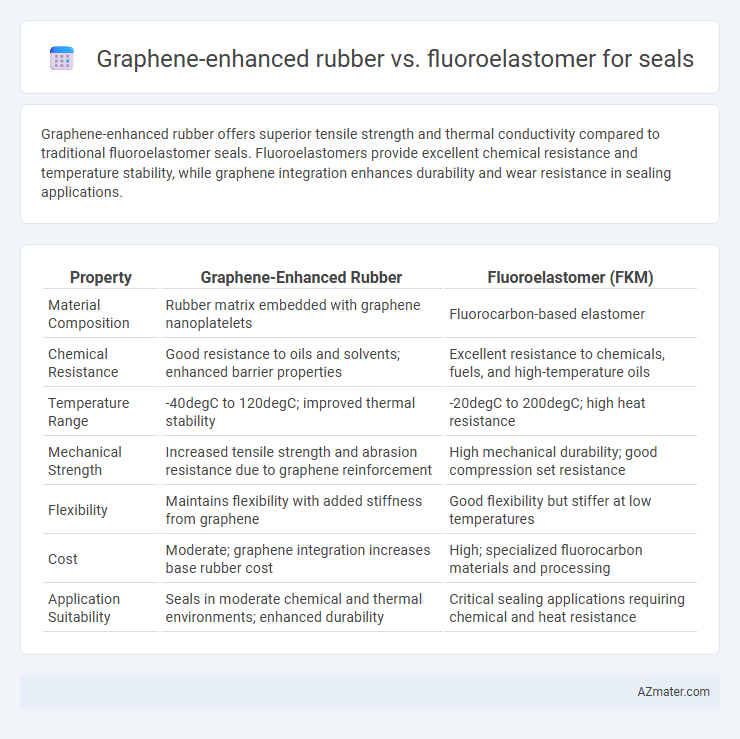Graphene-enhanced rubber offers superior tensile strength and thermal conductivity compared to traditional fluoroelastomer seals. Fluoroelastomers provide excellent chemical resistance and temperature stability, while graphene integration enhances durability and wear resistance in sealing applications.
Table of Comparison
| Property | Graphene-Enhanced Rubber | Fluoroelastomer (FKM) |
|---|---|---|
| Material Composition | Rubber matrix embedded with graphene nanoplatelets | Fluorocarbon-based elastomer |
| Chemical Resistance | Good resistance to oils and solvents; enhanced barrier properties | Excellent resistance to chemicals, fuels, and high-temperature oils |
| Temperature Range | -40degC to 120degC; improved thermal stability | -20degC to 200degC; high heat resistance |
| Mechanical Strength | Increased tensile strength and abrasion resistance due to graphene reinforcement | High mechanical durability; good compression set resistance |
| Flexibility | Maintains flexibility with added stiffness from graphene | Good flexibility but stiffer at low temperatures |
| Cost | Moderate; graphene integration increases base rubber cost | High; specialized fluorocarbon materials and processing |
| Application Suitability | Seals in moderate chemical and thermal environments; enhanced durability | Critical sealing applications requiring chemical and heat resistance |
Introduction to Advanced Seal Materials
Graphene-enhanced rubber offers superior mechanical strength, thermal conductivity, and chemical resistance compared to traditional seal materials, making it ideal for high-performance sealing applications. Fluoroelastomers, known for their exceptional resistance to heat, chemicals, and oil, have long been the standard in advanced seals for harsh environments. Both materials provide advanced solutions, with graphene-enhanced rubber pushing the boundaries of durability and flexibility while fluoroelastomers ensure reliability in extreme conditions.
Overview of Graphene-Enhanced Rubber
Graphene-enhanced rubber exhibits significantly improved mechanical strength, thermal conductivity, and chemical resistance compared to traditional elastomers, making it highly suitable for seal applications in extreme environments. The incorporation of graphene nanosheets creates a dense, durable matrix that enhances sealing performance by reducing permeability and increasing wear resistance. This advanced material offers superior longevity and reliability in demanding industrial settings, outperforming conventional fluoroelastomers in thermal stability and mechanical integrity.
Properties and Composition of Fluoroelastomer
Fluoroelastomers are synthetic rubber compounds composed primarily of vinylidene fluoride and hexafluoropropylene monomers, known for their exceptional chemical resistance and high-temperature stability up to 250degC. Their molecular structure provides excellent resistance to oils, fuels, and aggressive chemicals, making them ideal for seals in demanding environments. Compared to graphene-enhanced rubber, fluoroelastomers offer superior durability in harsh chemical conditions but generally have lower tensile strength and flexibility.
Mechanical Strength Comparison
Graphene-enhanced rubber exhibits superior mechanical strength compared to fluoroelastomer seals, offering enhanced tensile strength and improved resistance to wear and tear. The integration of graphene nanoparticles significantly increases elasticity and durability, resulting in longer seal life under high pressure and dynamic conditions. Fluoroelastomers provide excellent chemical resistance but typically fall short in mechanical robustness when benchmarked against graphene-reinforced rubber materials.
Chemical Resistance: Graphene-Enhanced Rubber vs Fluoroelastomer
Graphene-enhanced rubber exhibits superior chemical resistance due to graphene's impermeability and strong barrier properties, effectively protecting seals against aggressive acids, solvents, and oils. Fluoroelastomers, known for their exceptional resistance to a wide range of chemicals including hydrocarbons and high-temperature fluids, perform reliably in harsh environments but may degrade under strong alkalis and certain ketones. The integration of graphene into rubber matrices enhances mechanical strength and extends the chemical resistance spectrum, making it a competitive alternative to traditional fluoroelastomer seals in demanding industrial applications.
Thermal Stability and Temperature Performance
Graphene-enhanced rubber exhibits superior thermal stability withstanding temperatures up to 250degC, while fluoroelastomers typically perform effectively between -40degC and 200degC. The graphene-infused material offers enhanced heat resistance and improved mechanical strength under high-temperature conditions, making it ideal for extreme thermal environments. Fluoroelastomers provide excellent chemical resistance but their temperature performance is generally limited compared to the advanced thermal durability of graphene-enhanced rubber.
Durability and Longevity for Sealing Applications
Graphene-enhanced rubber exhibits superior durability due to graphene's exceptional tensile strength and resistance to wear, significantly extending seal lifespan in harsh environments. Fluoroelastomers offer excellent chemical resistance and thermal stability, maintaining sealing integrity under aggressive chemicals and high temperatures but may degrade faster under mechanical stress. For sealing applications demanding extended longevity with mechanical durability, graphene-enhanced rubber provides a more robust solution, whereas fluoroelastomers excel in chemically aggressive or high-temperature scenarios.
Cost and Manufacturing Considerations
Graphene-enhanced rubber offers cost advantages due to lower raw material expenses and simpler manufacturing processes compared to fluoroelastomers, which require expensive fluorinated compounds and specialized equipment for production. The incorporation of graphene can improve mechanical properties and durability without significantly increasing processing complexity, leading to reduced overall manufacturing costs. Fluoroelastomers, despite higher costs, provide superior chemical resistance and thermal stability, necessitating cost-benefit analysis based on application-specific performance requirements.
Environmental Impact and Sustainability
Graphene-enhanced rubber exhibits superior durability and reduced wear, leading to longer seal lifespans and decreased material waste compared to fluoroelastomers, which are derived from perfluorinated compounds with significant environmental persistence and disposal challenges. The incorporation of graphene reduces the need for frequent replacements and lowers carbon emissions associated with manufacturing and logistics. Fluoroelastomers, while chemically resistant, pose sustainability concerns due to their chemical stability hindering biodegradability and recycling efforts, making graphene-enhanced rubber a more environmentally friendly sealing solution.
Optimal Applications: Choosing the Right Seal Material
Graphene-enhanced rubber offers superior mechanical strength, chemical resistance, and thermal stability, making it ideal for seals in high-pressure industrial machinery and harsh chemical environments. Fluoroelastomer excels in extreme temperature ranges and exposure to aggressive fuels, oils, and solvents, making it the preferred choice for automotive and aerospace seals. Selecting the right seal material requires matching the operating temperature, chemical exposure, and mechanical stress to ensure optimal performance and durability.

Infographic: Graphene-enhanced rubber vs Fluoroelastomer for Seal
 azmater.com
azmater.com